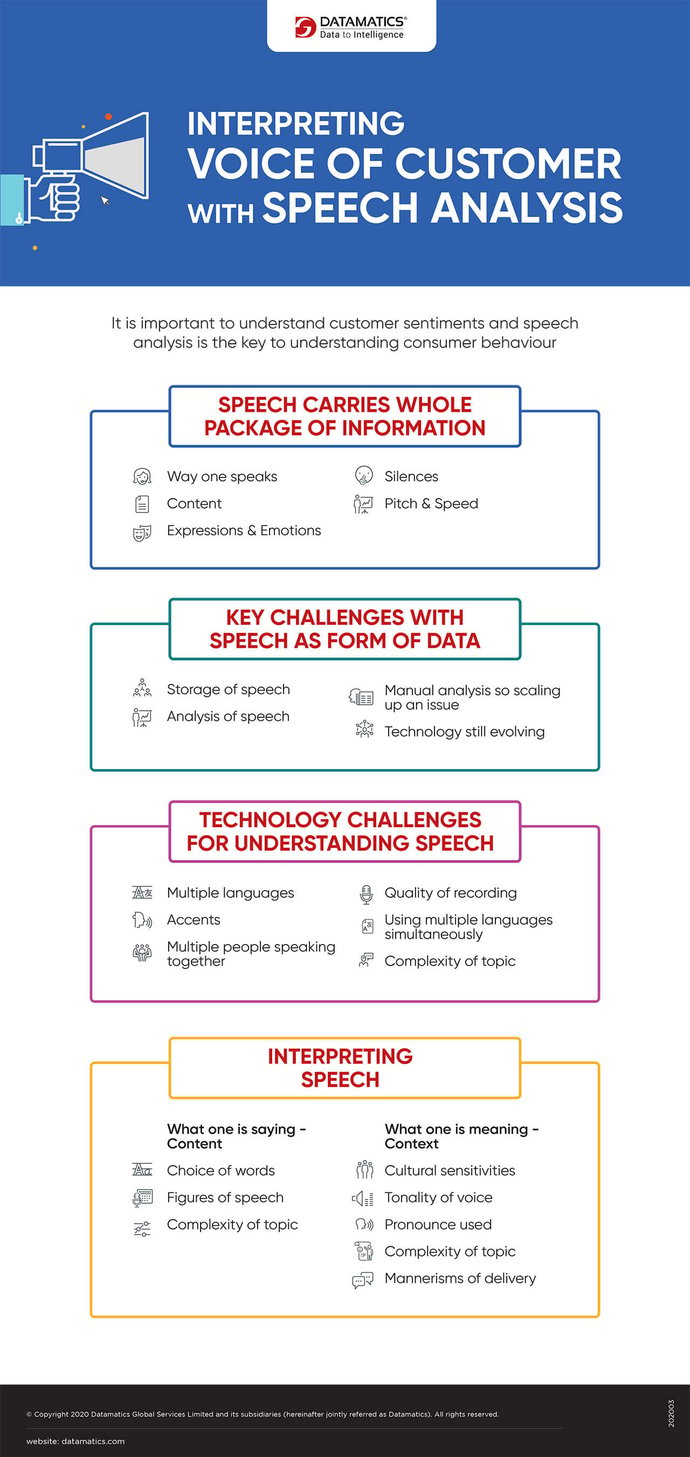A beginner’s guide to the Role of Augmented Analytics in Consumer Behavior Analysis
by Sandeep Arora, on Dec 23, 2019 12:51:36 PM
Estimated reading time: 3 mins
Data to Intelligence has always been a quest for humanity. More specifically in the field of Consumer Behavior Analysis, which has to deal with high data volumes to generate key business insights towards achieving market relevance. This task is simply mammoth. It is akin to the process of extracting gasoline from crude oil or, more specifically, the elixir from a massive assortment of minerals and herbs.

In Consumer Behavior Analysis, you not only analyze what is said but also what is not said – the finer nuances including the expressions, the emotions, the silences, the pitch, the speed at which the subjects talk, etc., while keeping in with the larger context.
Decoding speech as a form of data |
Download infographic >>
Here, Augmented Analytics, or analytics powered by Artificial Intelligence (AI)/Machine Learning (ML) and Natural Language Processing (NLP), enables you with technology-assisted consumer behavior analysis and expedites the entire process.
However, unless suitable storage is in place, be it in the form of a Data Lake or an ECM system, which not only supports Big Data but also elastic search, you cannot analyze the data to derive any actionable insights, whether prescriptive or predictive. Thus to say, Augmented Analytics is a function of an efficient storage facility, which enables the data preparation through the insights generation process.
The milestones in the consumer behavior analysis journey
This Data to Intelligence journey can be broadly segregated into the following steps:
- Data preparation:
It helps you develop and maintain clean unified data for quick and secure access to enterprise information. This step is an important part of Enterprise Data Management. Here, AI/ML helps you speed the process. - Augmented Analytics:
It works only with prepared data. So to say, Augmented Analytics is also the function of prepared data, in absence of which it is difficult to derive meaningful insights.
Here, analytics integrated with AI/ML and NLP algorithms enables you to go beyond the two-dimensional aspects of analytics and build advanced analytical models with contextual awareness across the entire data collection.
Augmented Analytics facilitates unbiased decision making and eliminates early hypothesis. It offers a 360-degree view of the data structures, bridges capability gaps, and enables to see beyond numbers and figures.
This Augmented Analytics paradigm gets only stronger while handling larger data sets. It enables you to organically interact with data and identify trends. - BI and Insights generation:
It offers interactive visual analytics through a high degree of Human-Machine collaboration, which results in continuous up-gradation of the data and offers more intelligent insights with the passage of time.
The business impact of Augmented Analytics
Systematic use of Augmented Analytics powered by AI/ML and NLP for analyzing consumer data reduces the time required in gathering, preparing, and curating data by 80%. It enables execution of time-consuming tasks with ease and with a higher level of accuracy. It adds more value to your Enterprise Data Management. It thus allows content analysts to focus their time on extracting more actionable insights.
Augmented Analytics enables you to use data for insight generation irrespective of the format and the quanta. It empowers you to do better storytelling using data while maintaining a strong focus on contextual awareness. It enables you to move away from passive data consumption to intelligent insight generation.
Augmented Analytics enables you to transform Big Data to Smart Data and succeed in the Data to Intelligence journey. It enables you to move away from the development of customized reports to AI-enabled smart searches over augmented knowledge repositories. It enables you to generate better and faster insights even with complex data, without an excessive dependency on data scientists as well as third parties, and stay ahead of competition. The insights help you achieve market resonance, relevance, and attunement with customers. In short, it helps you to be responsive and adaptive to changing market trends. It is truly a digital innovation and not just transformation that allows you to achieve digital efficiencies.



















